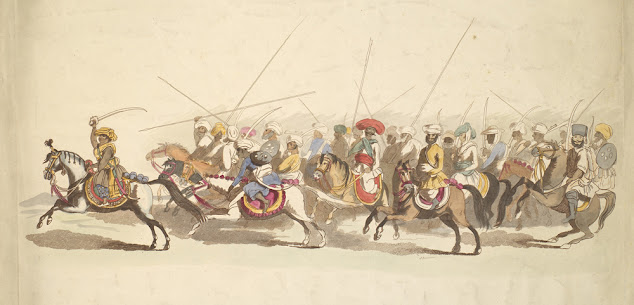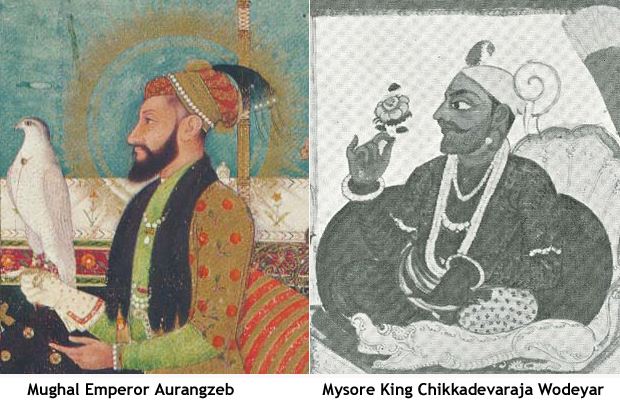Koodli Mutt massacre- The forgotten Peshwa Maratha attacks on Temples in Karnataka
Introduction
The Third Anglo Mysore War (1790-92 CE) saw Maratha Armies under Parshuram Bhau and Hari Pant (spelled Puraseram Bhow and Hurry Punt respectively by contemporary English writers) sweep through most settlements and farmlands of Mysore Kingdom (a big part of which is the present day state of Karnataka). The Marathas were in action with a detachment of British East India Company's Bombay Army led by Captain little from May 1790 to June 1792. Both Hari Pant and Parshuram Bhau had about 12,000 men with them (1).
While the general populace suffered heavily, contemporary writings say the non-Brahmins, referred to as Shudras by Francis Buchanan (2), suffered the most. While one reason for this was the segregation of residential layouts based on 'varna' or caste system in which Brahmins resided in the most fortified part of a settlement or even within actual forts, a closer look reveals the deliberate targeting of non-Brahmins/ Dalits by the Maratha Armies.
Koodli (or Kudli) is a small village about 16 km from Shivamogga (Shimoga) Town in Karnataka. Known for its Hindu temples, it is located at the junction of Tunga and Bhadra rivers that originate in the tropical mountain forests of south-western India's Western Ghats not far away. Like many other Hindu pilgrimage centres this place has its own share of temples that were patronised by well-known Hindu preachers over the centuries.
Buchanan claims to have traveled from Madras across the regions of Malabar (current Kerala state), Old Mysore and Coastal Karnataka and the Baramahal (Tamil Nadu) from 23rd April 1800 to 6th July 1801. He has written about the social, economic and political life that he claims to have seen and heard along way. It must be added here that Buchanan was appointed by Marquis Wellesley, Governor General of India for this job and his journal was published on orders of the Directors of the East India Company in 1807. Incidentally his stories have shaped the modern political discourse of Karnataka every since. He has been selectively quoted by right-wing Hindutva writers who use his accounts to build their narrative, particularly on Haidar Ali and his son Tipu Sultan, the late 18th century rulers of Mysore Kingdom.
During his travel from Shivamogga Town to Koodli village on 4th April 1801, Buchanan claims to have come across saw a soldier of the Bombay Army suffering from severe pain but not a single villager coming forward to help him. He writes:
'Mid-way I came to a village, where the inhospitality disposition of the natives fully manifested itself. Near the village, I overtook a Sepoy lying in the utmost agony from a rupture. Having with some difficulty reduced it, the pain in his groin was succeeded by a violent colic, which contracted his limbs; and, had any exercise been at all proper for a man in his condition, rendered him totally unable to walk. I therefore went to the village, in order to procure a cot or bedstead, of which a litter could be readily made. As I had left all my attendants with the sick man, except an interpreter, the villagers held me in contempt. I found the Gauda, his brother, and some head men of the village, all Sivabhactars*, standing in conversation, and wrapped up in their blankets. Having made known to them my case, Gauda replied, that they had no cots, and his brother talked very loud, and in an insolent manner. This was checked by the coming up of a superior officer of revenue, who informed me that there were cots in every house; but neither offers of payment, nor threats of complaint, were of more avail than humanity. In excuse for these people it may however be said, that the Sepoy belonged to the Bombay army, a detachment of which had enabled Puraseram Bhow to commit all his cruelties. Not that the Bombay army had any share in these excesses ; but without its assistance he either would not have ventured into the country at all, or would have assuredly defeated at Shiva-mogay.'
*Buchanan spelled Shiva Bhaktas (devotees of Hindu God Shiva) as Sivabhactars.
As people who had access to most resources of the state the Brahmins of Koodli like elsewhere in the Kingdom seemed to have fared better than the others in overcoming the war's effects. Buchanan continues:
'Charity of a great Brahman
The Swami is said to have been of great use in the famine, and to have employed the utmost of his influence in collecting money to support the starving wretches. He daily fed 3000 Brahmans, and other religious mendicants; for, according to the Hindu doctrine, it is the charity which is bestowed on religious men that chiefly procures favour in the eyes of the gods. In his distributions the Swami is said to have expended six Lacs of Rupees, most of which was collected in the Marattah States.'
In contrast the stories of suffering of the non-Brahmins are numerous and they must surely have taken much longer time to overcome the war's effects. Buchanan writes he visited Nagamangla town (Mandya District) on 21 August 1800. Before Parshuram Bhau's invasion the town apparently had 1,500 houses but only 200 survived his destruction. He claims 150,000 (1.5 lakh) palm trees were vandalised and cut by Bhau's armies. Half the farmers, mainly from the Tigala community, fled the area as refugees.
Bowring, Chief Commissioner of Mysore and Coorg wrote the following about the destruction in Chitradurga District by the Maratha Army between 1790 and 1792 CE. (4)
'In former days, the Chitaldroog district was much exposed to the depredations of the Mahrattas, whose principal leader, Parsuram Bhau ruthlessly plundered the northern part of the Mysore province. It was no uncommon thing for the whole population to desert their homesteads, leaving their houses, and carrying with them all their portable property, while, under the appellation of the 'Valase,' they wandered about the country till the invaders retired, and circumstances enabled them to return to their native villages.'
(1) Moor, Edward., 'A narrative of the operations of Captain Little's detachment, and of the Mahratta army, commanded by Purseram Bhow; during the late confederacy in India, against the Nawab Tippoo Sultan Bahadur', London, J.Johnson, 1794.
(2) Buchanan,Francis., 'A journey from Madras through the countries of Mysore, Canara, and Malabar', 3 volumes, 1807.
(4) Bowring, Lewin B., 'Eastern Experiences', 1871.
इस ब्लॉग को हिंदी में पड़ने के लिए यहाँ क्लिक करें
You may also like to read...
Eyewitness accounts of 26 Hindu temples / towns attacked by Maratha soldiers, along with Sringeri temple, in 1790 - 92 CE






Amazing. This narrative must be made mainstream
ReplyDelete